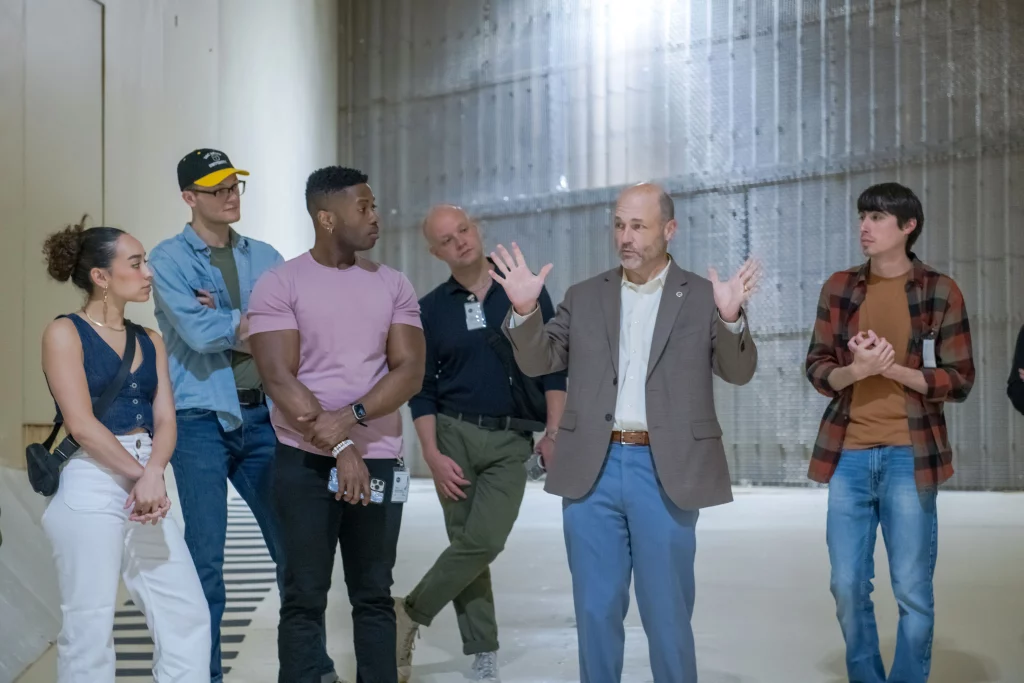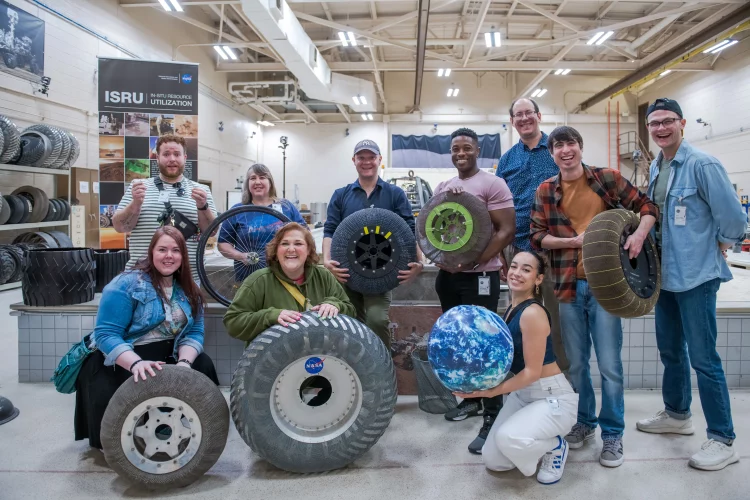Introduction
When “Back to the Future” debuted in 1985, it quickly became a beloved sci-fi classic. Directed by Robert Zemeckis and starring Michael J. Fox and Christopher Lloyd, the film’s unique time-travel story and imaginative technological fantasies captivated audiences worldwide. The film’s time machine, flying cars, and future tech not only sparked public imagination but also had a lasting impact on discussions about future technologies.
On the other hand, the National Aeronautics and Space Administration (NASA), as a leading space exploration agency, has continually pushed the boundaries of science and technology. In recent years, NASA’s future missions include lunar exploration, Mars exploration, deep space missions, and advanced aviation technologies. These missions not only provide new perspectives on scientific research but also play a crucial role in the development of future technologies.
When the cast of “Back to the Future” visited NASA, it was not only a cultural intersection but also a profound dialogue between science and fantasy. This article will explore the cast’s visit to NASA, delve into the details of NASA’s future missions, and examine the profound impacts of this event on both technology and culture.
Background of the Back to the Future Cast’s Visit to NASA
The History and Impact of the Back to the Future Series
The “Back to the Future” series, produced by Steven Spielberg and directed by Robert Zemeckis, stars Michael J. Fox and Christopher Lloyd. The first film, which follows Marty McFly (played by Michael J. Fox) and his friend Dr. Emmett Brown (played by Christopher Lloyd) on their time-travel adventures, combines elements of science fiction and adventure to portray a creatively imagined future world.
Many of the concepts from the film, such as the time machine, flying cars, and automated technology, were once considered pure science fiction. However, as technology has evolved, some of these elements have started to become a reality. The success of the film is not only measured by its box office and critical acclaim but also by its profound influence on the public’s perception of technology and the future. The film has inspired curiosity about future technologies and sparked discussions on scientific advancements.
The Motivation and Significance of the Visit to NASA
The cast of “Back to the Future” visited NASA to explore and understand real-world technology. While the technological fantasies in the film are imaginative, they are not without basis. Many sci-fi concepts are rooted in predictions and hopes about scientific progress, and NASA represents the forefront of these scientific advancements.
Through the visit, the cast sought to compare the film’s technological visions with current technological achievements and explore potential future developments. This visit was not only a retrospective on the film’s history but also a deep dialogue with science and technology. For audiences, it is an opportunity to understand how modern technology is realizing sci-fi dreams.
Overview of NASA’s Future Missions
Human Lunar Exploration Program (Artemis Program)
The Artemis program is one of NASA’s core missions, aiming to return humans to the Moon and establish a sustainable presence there. This program marks a new phase in human lunar exploration and involves the application of several cutting-edge technologies.
Objectives and Phases: The Artemis program is divided into several phases, including Artemis I, II, and III. Artemis I is an uncrewed test flight designed to evaluate the performance of the new Space Launch System (SLS) and the Orion spacecraft. Artemis II will be the first crewed flight mission, intended to send astronauts to lunar orbit in preparation for actual lunar landings. Artemis III aims to achieve human lunar landings again and establish a long-term presence in the lunar polar regions.
Scientific Exploration: The scientific goals of the Artemis program include studying ice resources in the lunar polar regions, which could provide critical support for future deep space missions. Establishing a lunar base will provide technological support and valuable experience for future Mars missions, advancing human progress in deep space exploration.
International Cooperation and Commercial Participation: The Artemis program involves not only American efforts but also international collaboration and commercial participation. NASA’s partnerships with other countries and private sectors will drive global technological innovation and resource sharing, fostering international scientific cooperation and technological development.
Mars Exploration and Colonization Plans
Mars exploration has long been a major goal for NASA. With technological advancements, NASA has gradually expanded its exploration of Mars and is now planning future colonization missions.
Exploration Missions: NASA’s “Curiosity” and “Perseverance” rovers are conducting significant scientific research on Mars, including geological surveys, climate monitoring, and searching for signs of life. These exploration missions provide valuable data about Mars and lay the groundwork for future crewed missions.
Mars Colonization: In the future, NASA plans to prepare for long-term colonization of Mars through projects like Mars 2020. This involves researching Mars’s surface resources, establishing self-sustaining ecosystems, and developing technologies necessary for survival on Mars. Mars colonization presents not only technical challenges but also ethical and societal considerations.
Challenges and Opportunities: Mars missions face numerous challenges, such as radiation protection, resource utilization, and environmental adaptation. However, these challenges drive technological advancements and human exploration spirit, laying the foundation for future scientific and technological progress.
Deep Space Exploration and Other Planetary Missions
In addition to the Moon and Mars, NASA plans to explore other planets and celestial bodies in the solar system to expand our understanding of the universe.
Jupiter and Saturn Exploration: NASA’s “Juno” spacecraft is studying Jupiter’s climate, magnetic field, and moons, providing valuable data about the gas giant. Upcoming missions, such as the exploration of Saturn’s moon Titan, aim to investigate its liquid lakes and oceans, potentially finding environments that could support life.
Asteroid and Comet Exploration: By exploring asteroids and comets, NASA aims to understand these celestial bodies’ composition and history, revealing early stages of the solar system’s formation. These missions not only provide important clues about the origins of the universe but may also discover valuable resources.
Deep Space Missions: NASA is also planning deep space missions to explore regions far from Earth. These missions will help scientists study the structure and evolution of the universe, search for extraterrestrial life, and expand human knowledge of the cosmos.
Advanced Aviation Technologies and Earth Observation Programs
NASA has made significant advances in aviation technology and Earth observation, with direct impacts on scientific research and public life.
Advanced Aviation Technologies: NASA is developing next-generation aircraft to improve the efficiency and environmental sustainability of aviation. Innovations such as new supersonic aircraft and electric planes aim to reduce noise and emissions, driving sustainable development in the aviation industry. These technological breakthroughs will transform future air travel, offering a more eco-friendly and efficient flying experience.
Earth Observation Programs: NASA’s Earth observation missions include monitoring climate change, natural disasters, and environmental changes. Through satellite observations, scientists can collect global data, study the impacts of climate change, and develop strategies for mitigation. These missions are crucial for understanding Earth’s environment and protecting ecosystems.
The Back to the Future Cast’s Visit to NASA
Interviews with NASA Scientists and Engineers
During their visit to NASA, the cast of “Back to the Future” engaged in in-depth interviews with various scientists and engineers. These interviews covered a range of topics from lunar exploration to Mars missions, with the cast showing keen interest in NASA’s cutting-edge research.
Introduction to Scientists: Scientists discussed their research areas and future missions, explaining how they utilize the latest technologies for scientific exploration and data analysis. The cast learned how complex scientific principles are applied in real-world missions and the impact of these missions on future technology.
Engineers’ Insights: Engineers showcased NASA’s work in spacecraft design, system integration, and mission execution. They discussed how they overcome technical challenges to ensure mission success. These insights provided the cast with a deeper understanding of the complexity and innovation involved in space exploration.
Touring NASA’s Facilities and Laboratories
The cast toured several key NASA facilities, including control centers, laboratories, and research centers. They witnessed firsthand how NASA plans, simulates, and tests technologies.
Control Centers: At the control center, the cast observed the process of mission command and monitoring, learning how NASA tracks spacecraft in real time and coordinates efforts across various departments.
Laboratories: In the laboratories, the cast explored various scientific equipment and experimental facilities, understanding how scientific experiments and technology tests are conducted. These labs are crucial for NASA’s advanced research and technology development.
Comparing Sci-Fi and Real-World Technology
The visit allowed the cast to compare the sci-fi technologies portrayed in “Back to the Future” with real-world advancements. Many of the film’s concepts, once deemed purely imaginative, are now becoming tangible through NASA’s work.
Time Machines and Space Travel: While the concept of a time machine remains fictional, NASA’s advancements in space travel and exploration echo some of the imaginative ideas from the film. The development of spacecraft and mission planning represents a step toward realizing aspects of the film’s vision of futuristic technology.
Flying Cars and Automated Technology: The film’s depiction of flying cars and automated technology reflects early futuristic dreams. NASA’s work on advanced aviation technologies, such as supersonic and electric aircraft, brings some of these dreams closer to reality, showcasing how technological progress can align with sci-fi fantasies.
Future Visions and Technological Realities: The visit highlighted how the future visions portrayed in “Back to the Future” align with or diverge from current technological realities. It illustrated the ongoing interplay between science fiction and actual scientific development, emphasizing the role of imagination in driving technological innovation.
Conclusion
The visit of the “Back to the Future” cast to NASA was a significant event, bridging the gap between science fiction and real-world technology. By exploring NASA’s future missions and engaging with scientists and engineers, the cast gained valuable insights into the advancements shaping our future.



















































Discussion about this post